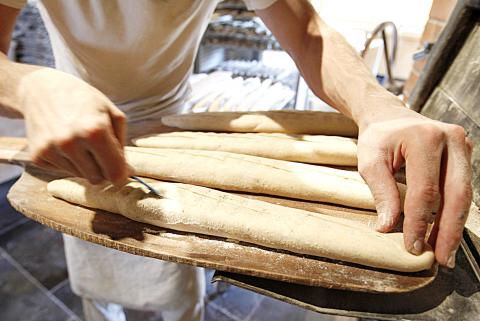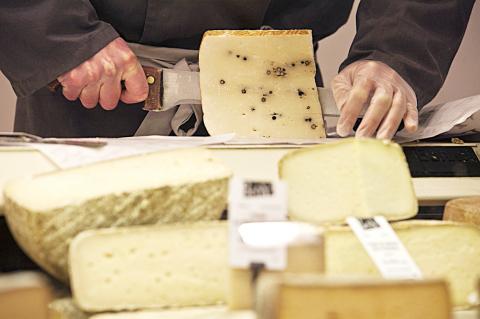In a country known for a statutory 35-hour work week and a generous work-life balance, the “Best Worker of France” contest may seem an anomaly.
But for the nearly 3,000 French hopefuls currently competing for the prestigious prize bestowed every four years, the coveted medal with its tricolor ribbon is a symbol of artisanal excellence, creativity and typically Gallic professional pride.
Bakers, chefs, glass-blowers, welders, landscape artists, lingerie makers, even designers of dental prostheses and dog groomers can become “One of the Best Workers of France,” a professional diploma now in its 90th year.

Photo: REUTERS
Qualifying tests began late in 2013 and continue in coming months, with a new batch of “Best Workers” to be honored next February out of an original pool of 2,689 candidates.
Last week, 473 hopefuls in the gastronomy category — whose president is acclaimed chef Alain Ducasse — gathered at catering schools in Paris for a written exam and practical test. Such are the sensitivities about winning and losing that organizers asked that all contestants remain anonymous in the competition phase.
“I’ve dreamed about this for a long time,” said a restaurant owner from eastern France’s Haute Savoie region on his third try for the award. “I’m doing it for my own personal satisfaction.”

Photo: Bloomberg
Organizers and former winners say the prize rewards years of hard work, sacrifice, and a rejection of the more relaxed work ethic that has grown in France throughout the 20th century and culminated in 2000’s law enshrining a 35-hour work week.
“It requires a big personal investment. You don’t get to be “Best Worker of France” in kicking back, that’s for sure,” said Alain Bariller, secretary general of the competition.
He said organizers noticed a dip in the number of applicants after the 35-hour work week came into being: “They said ... with the 35 hours in place now, I’d rather take vacation rather than throw myself into this tough competition.”
For the chefs, saddle of rabbit, quail and a perfectly cut potato were the basis of the 15-minute preliminary test that was stressful, given the short time, if relatively basic, some said.
“It was like going back in time 20 years when all we got to do was cut potatoes,” said the chef from the Haute Savoie.
Gilles Goujon, one of four jury presidents in the gastronomy group who will help decide who goes on to the next level in October, said his 1996 “Best Worker” distinction helped push him to earn three Michelin stars at his restaurant.
“It’s the best test in France,” he said. “After you win, you gain confidence and you can go on to even bigger things.”
Winners can wear the award’s distinctive blue, white and red stripes on their chef jackets for the rest of their careers.
BAKERS, BUTCHERS, ENERGY CONSULTANTS
Now in its 90th year, with nearly 8800 laureates since 1924, the professional diploma certifies mastery “in the exercise of a profession in the artisanal commercial service, industrial or agriculture domain.” The judges are former winners and experts in each field.
The contest is divided into 17 groups such as metal-working, textiles, construction and agriculture, with 136 occupations represented. Some of the oldest manual crafts still have pride of place, such as saddlery, millinery, stone-cutting and woodturning, not to mention butchers, bakers and cheesemakers.
But organizers, under the auspices of France’s education ministry, have striven in recent years to modernize the contest by including more service professions, thereby broadening the definition of what makes a “Best Worker” in the 21st century.
Today, consultants in energy efficiency or food security, swimming pool specialists and hotel receptionists are also in the running. Professions with enough adherents can lobby for inclusion in the contest.
While many public sector workers stick to the 35-hour work week in their contracts, the reality in the private sector is that hours are often much longer. A 2013 Labor Ministry report found that French workers on average worked 39.5 hours per week in 2011, not far behind the EU average of 40.3 hours.
The subtlety of the best worker distinction is lost on some.
“What’s the definition of ‘Best Worker’ anyway?” asked Paris taxi driver Djamel Maamar, who was familiar with the award but questioned why certain professions were included and others not.
“What’s the criterion? What about stress levels, or danger? Why isn’t there a ‘Best Taxi Driver of France’?” said Maamar, 31, adding he worked 60 hours a week, six days out of seven.
“In France, we just don’t appreciate the effort in work,” he said, adding that public servants with their limited hours and generous retirements have “the cushy jobs.”
France’s tough employment laws have led to a two-tier labor market in which those with permanent contracts enjoy high levels of job protection, often accompanied by generous perks, while the self-employed, or those on cheaper temporary contracts have no job security.
The contest has its origins in an early 20th century drive to boost apprenticeship, an effort that continues today.
As part of efforts to reduce unemployment and make France more competitive, Socialist President Francois Hollande hopes to increase the number of apprentices from 440,000 to 500,000 by 2017 through financial incentives, such as lower social charges for small business owners who take on apprentices.
France’s relatively low number of apprentices — Germany, for example, has about 1.5 million — is due to “the poor image of the vocational path and manual occupations,” according to a government report. Youth unemployment is at 23 percent.
According to Martial Carre, the first-ever dog groomer to win the award in 2011 after 30 years in the business, “The artisans are the ones making France run in terms of work.”
His profession and its demands go hand in hand with tendonitis, shoulder pain, even dog bites for the least experienced — all of which sit ill with young people, he said.
“There are a lot of professions like this with a lot of hours,” said Carre, 56, who also breeds fox terriers.
“Young people don’t want to do it — they think it’s too tough. Better to sit [in front of] a computer and push buttons.”

In the March 9 edition of the Taipei Times a piece by Ninon Godefroy ran with the headine “The quiet, gentle rhythm of Taiwan.” It started with the line “Taiwan is a small, humble place. There is no Eiffel Tower, no pyramids — no singular attraction that draws the world’s attention.” I laughed out loud at that. This was out of no disrespect for the author or the piece, which made some interesting analogies and good points about how both Din Tai Fung’s and Taiwan Semiconductor Manufacturing Co’s (TSMC, 台積電) meticulous attention to detail and quality are not quite up to

April 21 to April 27 Hsieh Er’s (謝娥) political fortunes were rising fast after she got out of jail and joined the Chinese Nationalist Party (KMT) in December 1945. Not only did she hold key positions in various committees, she was elected the only woman on the Taipei City Council and headed to Nanjing in 1946 as the sole Taiwanese female representative to the National Constituent Assembly. With the support of first lady Soong May-ling (宋美齡), she started the Taipei Women’s Association and Taiwan Provincial Women’s Association, where she

Chinese Nationalist Party (KMT) Chairman Eric Chu (朱立倫) hatched a bold plan to charge forward and seize the initiative when he held a protest in front of the Taipei City Prosecutors’ Office. Though risky, because illegal, its success would help tackle at least six problems facing both himself and the KMT. What he did not see coming was Taipei Mayor Chiang Wan-an (將萬安) tripping him up out of the gate. In spite of Chu being the most consequential and successful KMT chairman since the early 2010s — arguably saving the party from financial ruin and restoring its electoral viability —

It is one of the more remarkable facts of Taiwan history that it was never occupied or claimed by any of the numerous kingdoms of southern China — Han or otherwise — that lay just across the water from it. None of their brilliant ministers ever discovered that Taiwan was a “core interest” of the state whose annexation was “inevitable.” As Paul Kua notes in an excellent monograph laying out how the Portuguese gave Taiwan the name “Formosa,” the first Europeans to express an interest in occupying Taiwan were the Spanish. Tonio Andrade in his seminal work, How Taiwan Became Chinese,